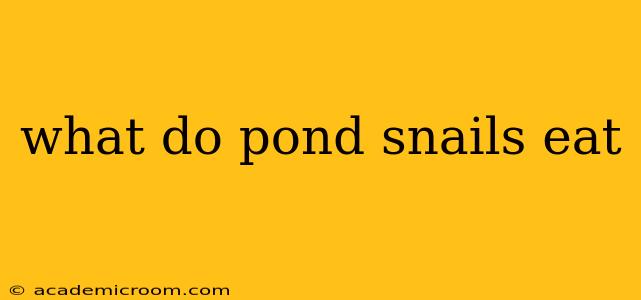Pond snails, those ubiquitous inhabitants of freshwater ecosystems, are fascinating creatures with surprisingly diverse diets. Understanding what they eat is crucial for maintaining a healthy pond environment and for anyone keeping them in aquariums. This comprehensive guide delves into the intricacies of a pond snail's diet, addressing common questions and misconceptions.
What is the main food source for pond snails?
The primary food source for most pond snails is algae. They graze on various types of algae, including filamentous algae, diatoms, and green algae, scraping them off surfaces using their radula – a ribbon-like structure with tiny teeth. This makes them important components of pond ecosystems, helping to control algae growth. However, their diet isn't limited to just algae; they are opportunistic feeders.
Do pond snails eat plants?
While algae form the cornerstone of their diet, many pond snail species will also consume decaying plant matter. They aren't typically considered major plant pests, but they can nibble on the leaves of live plants, especially if other food sources are scarce. The extent of their plant consumption varies greatly depending on the species and the availability of other food sources. Some species are more herbivorous than others.
What other foods do pond snails eat?
Beyond algae and plants, pond snails are scavengers and will consume various organic detritus. This includes:
- Decaying leaves: Fallen leaves provide nutrients and shelter for many pond creatures, including snails.
- Dead insects and other invertebrates: Snails contribute to the decomposition process by consuming dead animals.
- Bacteria and other microorganisms: These microscopic organisms are an important part of a pond snail's diet, providing additional nutrients.
- Fish food: If kept in aquariums alongside fish, they might consume leftover fish food.
Do pond snails eat each other?
While cannibalism isn't a common occurrence, it can happen under specific conditions, particularly if food is scarce or if there's a significant difference in size between snails. Smaller snails are more vulnerable to being eaten by larger ones.
What do pond snails NOT eat?
Pond snails generally avoid consuming hard, indigestible materials. They lack the specialized structures to break down tough substances like wood or rocks.
How do I feed pond snails in an aquarium?
If you keep pond snails in an aquarium, it's crucial to provide a balanced diet mimicking their natural environment. This includes:
- Algae wafers: These commercially available food pellets are specifically designed for aquatic snails and provide essential nutrients.
- Blanched vegetables: Small amounts of blanched vegetables like spinach or zucchini can supplement their diet. Ensure you remove any uneaten portions to prevent water quality issues.
- Pond plants: Introducing some hardy aquatic plants can provide both food and shelter for your snails.
Are pond snails harmful to my pond?
Generally, pond snails aren't harmful to a healthy pond ecosystem. In fact, their algae-consuming habits can be beneficial. However, in overcrowded situations or if the pond lacks sufficient natural food sources, their populations can explode, leading to potential problems with plant damage. Maintaining a balanced ecosystem and avoiding overfeeding is key.
This comprehensive overview sheds light on the fascinating dietary habits of pond snails, highlighting their importance in the aquatic food web and providing practical tips for maintaining them in a home aquarium setting. Remember, responsible observation and a balanced approach are key to ensuring the health of both your pond snails and their environment.
